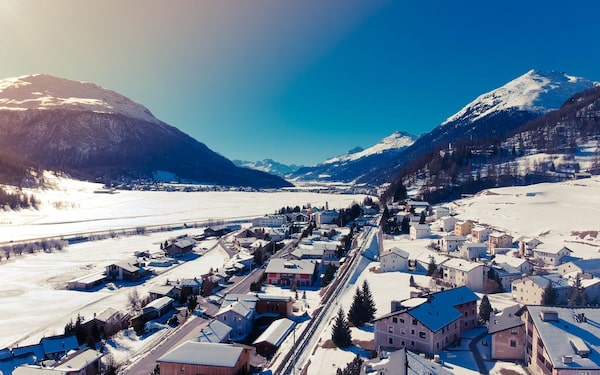
Thanks to one woman’s animal rescue efforts, you can now explore Madulain, in the Engadine Valley, accompanied by mountain goats.Arjan Janssen
The moment we locked eyes I knew he was the one for me. Sure, Momo was a mountain goat, but his gentle gaze lured me in. While the other members of our goat trekking group tour selected their four-legged partners from a herd of eight, I brushed Momo’s bristly coat and attached his leash. When everyone was ready – six women with six male mountain goats in tow – we set out on our trek through the snow-covered streets of the small Swiss town of Madulain.
It was early February, and our group had just spent three days learning to ski on the sun-drenched slopes of St. Moritz, only 15 minutes away by train. This midday excursion offered a new way to explore the Engadine Valley, a green-cloaked gorge that cuts along the base of the mountainous region located in the canton of Graubünden in southeast Switzerland. Madulain is the smallest town in the upper area, home to only 200 residents, and as we strolled through the streets, I was struck by the town’s charm, colourful homes and friendly faces we passed along the way.
While the terrain may seem like a natural place for mountain goats to roam, these friendly locals are relatively new neighbours in town. This guided experience, which connects visitors to the community and offers some calming nature-based animal therapy, is the result of one woman’s mission to save some baby goats and introduce visitors to this small corner of the country.
Nicole Buess started Mini Geiss-Dini Geiss (My Goat, Your Goat in Swiss) after learning of a practice by goat farmers that culls male goals. “Female goats are kept for their production of goat milk and fresh cheese, but only one male goat is needed in a herd for reproduction,” she said. “And often farmers will pass around a male goat to save on costs.”
In 2017, while walking her dogs, she passed a farm where five baby goats roamed. Every day she would chat with the farmer’s daughter, Fadrina, who eventually told her that the male goats would soon be headed to a butcher. “I was shocked, and told her, ‘Tell your father to wait,’” Buess shared with us.
She went home that day and immediately set out to find a solution to save those goats. After some research, she discovered that goat treks were being offered in other rural areas in Switzerland. Knowing that Engadine would have appeal – “The region is where Heidi took place, as well as the famous local story Schällenursli,” she explained – she set out to create a similar experience.

The writer, far right, and her four-legged tour guide Momo.Bianca Bujan
Of course, she had to get the goats first. She asked the farmer how much butchers pay for each goat, and on her 50th birthday, instead of gifts, Buess asked family and friends to donate money to help with the rescue.
The deeply personal nature of Buess’s mission comes across in her tours. Offering everything from goat yoga to full-day mountain treks – and the opportunity to be a farm hand for a day – Buess’s slow, meandering journeys take visitors to Madulain, Zuoz or St. Moritz and allow them to absorb the stunning scenery in a new and extremely memorable way. It’s a chance to meet locals, to learn more about mountain life in Switzerland, and to connect with the creatures in a way that helps us understand why their lives are worth saving.
The goats seemed happy to trot in tandem, leashed up but leading the way through town, and seeing our procession gave locals a reason to stop and chat with us. While the population was small, it seemed as though everyone was out for a walk – and happy to share the foot path with our four-legged friends. Curious dogs would step aside, sniffing their scent as we passed, and friendly onlookers waved from afar.
As we rounded a corner, our path opened up to a far-reaching field, framed by majestic mountains. “Ok ladies, now you can let them off!” Buess instructed. When we unclipped our goats, they galloped off gleefully – all except Momo, who took a few steps, and then stopped and looked back at me, as if beckoning me to follow. I picked up my pace to join him, and watched as the playful goats pranced about.
We wrapped up our two-hour walking tour by heading along a dirt trail that led back to the barn. Once the goats were returned to their home, we sat down on the grass by the barn and shared locally made Kaiserschmarrn, an Austrian, pancake-like dessert, and refreshing cups of juice.
As we sat quietly together on the hillside, I took in the stunning surroundings. Below us, the snow-cloaked cottages of Madulain seemed to shimmer in the sunlight, and directly across, a sky-reaching summit crowned with clouds created a surreal Swiss backdrop. I realized that the experience was about more than gallivanting with goats through the scenic Swiss alps; I had made a connection with people and a place I might not have stopped to pay attention to if it weren’t for Momo and his friends.
Goat treks are offered year-round and can be booked through minigeiss-dinigeiss.ch.
The writer was hosted by Tourism Switzerland. The organization did not review or approve the story prior to publication.